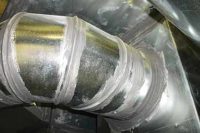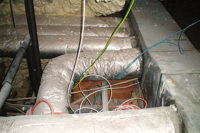Troubleshooting the air side of an HVAC system can be one of the most frustrating yet rewarding challenges a tech can experience in this industry. Airflow is at the core of forced-air contracting yet is one of the most misunderstood aspects of an HVAC system. This may be because it’s invisible.
To understand airflow, one must have a firm grasp of the rules driving its characteristics and behaviors. Many of the most complicated issues a tech encounters often tie to an airflow problem. Let’s look at five airflow rules that can help anyone in the industry master the airside of the profession.
Rule No. 1 – Airflow Takes The Path Of Least Resistance
Air is lazy and will always seek the path of least resistance. Airflow takes the easy way out as it moves around inside a duct system. It’s much easier for air to pass through a large duct leak (or multiple small leaks) near the equipment than to flow to the appropriate supply register or through the intended return grille.
Poorly installed filter racks or restrictive air filters take full advantage of this rule. Since airflow takes the path of least resistance, a poorly installed filter rack allows unfiltered air to go around the air filter instead of through it.
This unfiltered air might be carrying dirt and dust that is distributed by the HVAC system into the coil and the building, causing IAQ and maintenance concerns. Poorly installed coils follow the same rule.
Rule No. 2 — 1 cfm in Equals 1 cfm out
Airflow is measured in cfm (cubic feet per minute). To visualize cfm, imagine a 12-by-12-by-12-inch cardboard shipping box full of air. This roughly represents 1 cfm of airflow. For every 1 cfm of airflow that goes into the blower wheel of a fan, 1 cfm of airflow must also come out of the blower wheel.
For a 3-ton system operating in the cooling mode, a tech may measure actual fan airflow at the air-handling equipment and determine the system’s moving 1,200 cfm. This means 1,200 cfm of air is being pulled into the fan and 1,200 cfm of air is being discharged from the fan. It doesn’t mean 2,400 cfm of total airflow exists, as the system is only moving 1,200 cfm.
The fan is moving this amount of airflow from the return side of the system to the supply side of the system. This represents the amount of air that has to move through the duct system, too. The quality of the duct system installation determines whether the air makes it to the intended point.
Rule No. 3 – Airflow is Always Highest at the Equipment
Just as static pressure is always highest at the fan, airflow is also highest at the fan. The majority of duct systems leak, and as air moves toward the registers, the total amount of air in the system decreases. Think of air in ducts as water in a leaky pipe.
There is only so much airflow to move from the air-handling equipment through the duct system to individual rooms. If airflow is lost due to duct leakage, the system will not deliver optimal comfort.
To best use the airflow moved by the fan, it has to be contained. The only way to do this is by properly sealing the duct system. When a duct system leaks, and most do, there is no way to distinguish where airflow is going.
Proper airflow is important when trying to achieve comfort in individual rooms. If conditions in a duct system exist that allow air to bypass its intended delivery point, it will take the path of least resistance every time.
Rule No. 4 — Hot Air Rises, Cold Air Falls
Differences in air temperature create air movement. Hot air rises and cold air falls. Heated air will move towards the upper levels in a building while cooler air moves to the lower levels. This action often contributes to many comfort-related complaints from customers.
HVAC professionals have attempted to counter this action through the strategic placement of return grilles, often with limited success. In many cases, success has been achieved through the proper selection of supply registers. A good supply register can help mix conditioned air and room air to reduce large temperature variations in a room.
Another contributing factor to consider is building leakage. Building leakage can allow unconditioned air to be brought inside while conditioned air leaks out. If this is the cause of customers’ woes, return grille placement and supply register selection won’t be enough to cure the problem.
Rule No. 5 — Airflow Must Be Measured
The measurement of airflow is one of the greatest assumptions one can make. In the old days, I used the palm of my hand to measure airflow. My measurements consisted of “blows great” and “plenty of air.” I really had no idea if the proper amount was there.
The rubber meets the road when airflow is measured with the right test instruments. By measuring, the technician raises the bar and holds his profession accountable to the type of work it’s expected to perform.
Troubleshooting airflow is reduced to guesswork and rules of thumb in the absence of measurement. The information obtained from a few static pressure readings and a fan table may forever change how a person views an HVAC system.
Become a student of airflow. Begin studying and building on these five rules. And don’t stop there, as there are many more rules and laws that airflow abides by. The more a tech understands about airflow, the better he or she will become at mastering it.
Publication date: 7/18/2016
Want more HVAC industry news and information? Join The NEWS on Facebook, Twitter, and LinkedIn today!











